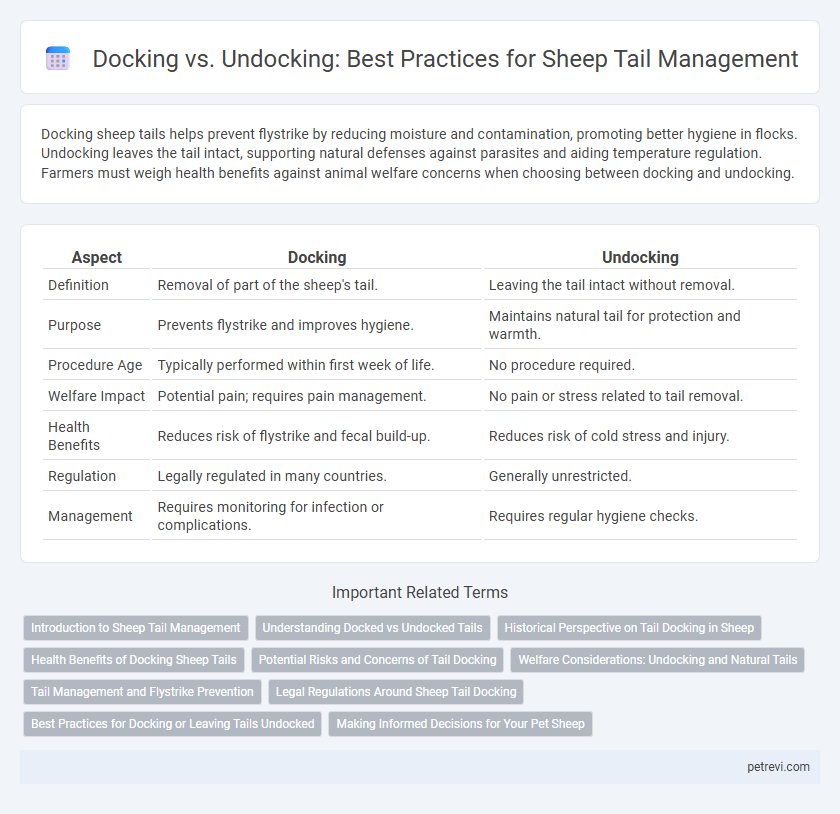Docking sheep tails helps prevent flystrike by reducing moisture and contamination, promoting better hygiene in flocks. Undocking leaves the tail intact, supporting natural defenses against parasites and aiding temperature regulation. Farmers must weigh health benefits against animal welfare concerns when choosing between docking and undocking.
Table of Comparison
| Aspect | Docking | Undocking |
|---|---|---|
| Definition | Removal of part of the sheep's tail. | Leaving the tail intact without removal. |
| Purpose | Prevents flystrike and improves hygiene. | Maintains natural tail for protection and warmth. |
| Procedure Age | Typically performed within first week of life. | No procedure required. |
| Welfare Impact | Potential pain; requires pain management. | No pain or stress related to tail removal. |
| Health Benefits | Reduces risk of flystrike and fecal build-up. | Reduces risk of cold stress and injury. |
| Regulation | Legally regulated in many countries. | Generally unrestricted. |
| Management | Requires monitoring for infection or complications. | Requires regular hygiene checks. |
Introduction to Sheep Tail Management
Sheep tail management is crucial for maintaining flock health and preventing flystrike, a common parasitic condition. Docking, the removal of part of the tail, reduces fecal contamination and improves hygiene, while undocking involves leaving the tail intact to preserve natural defense mechanisms. Effective tail management balances animal welfare with disease prevention by selecting the appropriate method based on breed, environment, and management practices.
Understanding Docked vs Undocked Tails
Docking sheep tails involves the removal of part of the tail to reduce fecal contamination and lower the risk of flystrike, while undocked tails remain intact, which can sometimes increase these risks but support natural behaviors. Docked tails typically measure about one-third to one-half of the original length, maintaining sufficient length for protection against environmental elements and parasites. Management decisions hinge on balancing animal welfare concerns, sheep breed characteristics, and local regulations governing tail docking practices.
Historical Perspective on Tail Docking in Sheep
Tail docking in sheep originated centuries ago as a measure to reduce the risk of flystrike and improve hygiene in flocks. Historically, docking was performed to minimize fecal soiling around the tail, which attracted blowflies and increased disease susceptibility. Despite evolving animal welfare standards, the practice remains embedded in traditional sheep husbandry due to its perceived benefits in flock health management.
Health Benefits of Docking Sheep Tails
Docking sheep tails significantly reduces the risk of flystrike, a common parasitic infection caused by blowfly larvae that thrive in soiled wool and fecal matter around long tails. Properly docked tails improve hygiene, minimize bacterial infections, and promote overall flock health by preventing accumulation of dirt and moisture. Studies show that docking within recommended guidelines enhances lamb welfare and reduces veterinary costs associated with tail-related diseases.
Potential Risks and Concerns of Tail Docking
Tail docking in sheep, a common practice aimed at preventing flystrike and improving hygiene, carries potential risks such as infection, excessive bleeding, and long-term pain or discomfort if not performed correctly. Undocking, or avoiding tail docking altogether, reduces these risks but may increase vulnerability to parasitic infestations and flystrike, which are significant welfare concerns. Effective sheep tail management requires balancing disease prevention and animal welfare while considering breed-specific susceptibility and farm management practices.
Welfare Considerations: Undocking and Natural Tails
Undocking sheep tails involves removing part of the tail to reduce the risk of flystrike and improve hygiene, but it raises welfare concerns related to pain and potential long-term sensitivity. Undocked sheep with natural tails require diligent management to prevent flystrike through regular crutching and shearing, which promotes better animal welfare by preserving natural anatomy and reducing surgical trauma. Effective welfare-focused tail management balances disease prevention with minimizing pain and maintaining natural behaviors.
Tail Management and Flystrike Prevention
Tail docking in sheep involves removing part of the tail shortly after birth to reduce fecal contamination and lower the risk of flystrike, a parasitic infestation. Undocked sheep tails can trap moisture and feces, creating an environment conducive to blowfly larvae invasion, especially in humid climates. Effective tail management through docking reduces flystrike incidence, improving sheep welfare and productivity.
Legal Regulations Around Sheep Tail Docking
Legal regulations around sheep tail docking vary significantly by country, with many jurisdictions enforcing strict guidelines to ensure animal welfare. In the European Union, tail docking is only permitted for specific breeds and must follow veterinary recommendations to minimize pain and distress. In contrast, countries like Australia have established codes of practice that allow docking up to a certain tail length to prevent flystrike, mandating proper pain relief methods during the procedure.
Best Practices for Docking or Leaving Tails Undocked
Tail docking in sheep reduces the risk of flystrike by minimizing fecal contamination and moisture around the tail area, thereby improving flock health and welfare. Best practices for docking include leaving enough tail length to cover the vulva in ewes to prevent reproductive issues, performing the procedure at an early age with proper pain management, and maintaining a clean environment to reduce infection risks. Conversely, leaving tails undocked requires vigilant hygiene and regular monitoring to mitigate flystrike and ensure overall animal well-being.
Making Informed Decisions for Your Pet Sheep
Tail docking in sheep involves the surgical removal of part of the tail to prevent flystrike and improve hygiene, while undocking refers to leaving the tail intact to support natural behaviors and protection against environmental elements. Evaluating factors such as breed, farm management practices, and local regulations is essential when deciding between docking and undocking, ensuring animal welfare and compliance. Consulting with a veterinarian and considering the welfare implications will help make informed decisions that best suit your pet sheep's health and wellbeing.
Docking vs Undocking for Sheep Tail Management Infographic

 petrevi.com
petrevi.com